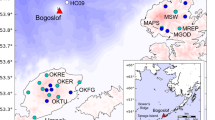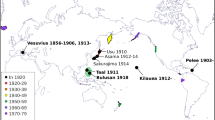Abstract
Data collected by a pressure sensor provide new insights into the 1999 eruption of Shishaldin volcano, Unimak Island, Alaska. On 19 April 1999, after 3 months of unrest and an extended period of low-level Strombolian activity, Shishaldin experienced a Subplinian eruption (ash plume to >16 km), followed by several episodes of strong Strombolian explosions. Acoustic data from the pressure sensor allow us to investigate the details of an eruption which was instrumentally well recorded, but with few visual observations. In the 12 h prior to the Subplinian phase, the pressure sensor detected a series of small, repeated pulses with a constant spectral peak at 2–3 Hz. The amplitude and occurrence rate of the pulses both grew such that the signal became a nearly continuous hum just before the Subplinian eruption. This humming signal may represent gas release from rising magma. The main Subplinian phase was heralded by (1) the abrupt end of the humming signal, (2) several pulses of low-frequency sound interpreted as ash bursts, and (3) a dramatic increase in seismic tremor amplitude. The change in acoustic signature at this time allows us to precisely time the start of the Subplinian eruption, previously approximated as the time of strongest tremor increase. The 50-min Subplinian phase actually contained several bursts of signal, each of which may represent a discrete volume of magma passing through the system. Following the Subplinian event, the pressure sensor recorded four discrete episodes of Strombolian gas explosions on 19–20 April and another on 22–23 April. Four of the five episodes were accompanied by strong seismic tremor; the fifth has not been previously recognized and was not associated with anomalous tremor amplitudes. In time series these events are similar to explosions recorded at other volcanoes but in general they are much larger, with maximum amplitudes of >65 Pa at 6.5 km from the vent, and they have low (0.7–1.5 Hz) peak frequencies. These large explosions occurred at rates of 3–20 per minute for 1–5 h in each episode. The explosions were accompanied by a small (<5 km above sea level) ash plume and only minor amounts of ejecta were produced. Thus, the explosion activity was dominated by gas release.









Similar content being viewed by others
References
Benoit JP, Thompson G, Lindquist K, Hansen R, McNutt SR (1998) Near-real-time WWW-based monitoring of Alaskan volcanoes: The IceWeb system. EOS Trans Am Geophys Union 79:F957
Caplan-Auerbach J, McNutt SR, Vergniolle S, Boichu M (2002) Acoustic recordings of Strombolian and Subplinian activity at Shishaldin volcano, Alaska. EOS Trans Am Geophys Union 83:S386
Coltelli M, Del Carlo P, Vezzoli L (1995) Stratigraphy of the Holocene Mt. Etna explosion eruptions. Per Mineral 64:141–143
Dehn J, Dean KG, Engle K, Izbekov P (2002) Thermal precursors in satellite imagery of the 1999 eruption of Shishaldin volcano. Bull Volcanol (in press) DOI 10.1007/s00445-002-0227-0
Dewey JM (1985) The propagation of sound from the eruption of Mt. St. Helens on May 18 1980. Northwest Sci 59:79–92
Fairfield C (1980) OMSI Sound Project: the acoustic effects of the Mount St. Helens eruption on May 18, 1980. Oregon Geol 42:200–202
Firstov PP, Kravchenko NM (1996) Estimate of the amount of explosive gas released in volcanic eruptions using air waves. Volcanol Seismol 17:547–560
Garces M, Iguchi M, Ishihara K, Morrissey M., Sudo Y, Tsutsui T (1999) Infrasonic precursors to a Vulcanian eruption at Sakurajima Volcano, Japan. Geophys Res Lett 26:2537–2540
Hagerty MT, Schwartz SY, Garces MA, Protti M (2000) Analysis of seismic and acoustic observations at Arenal Volcano, Costa Rica, 1995–1997. J Volcanol Geotherm Res 101:27–65
Houghton BF, Sable JE, Wilson CJN, Coltelli M, Del Carlo P (2001) The influence of conduit processes during basaltic Plinian eruptions. Trans AGU 82(47):F1412
Johnson JB (2000) Interpretation of infrasound generated by erupting volcanoes and seismo-acoustic energy partitioning, PhD Thesis, University of Washington
Johnson JB, Lees JM (2000) Plugs and chugsseismic and acoustic observations of degassing explosions at Karymsky, Russia and Sangay, Ecuador. J Volcanol Geotherm Res 101:67–82
Johnson JB, Malone SD (1997) Acoustic air-wave propagation from the 1980 Mount St. Helens Eruption. EOS Trans AGU 78(46):F130
Johnson JB, Lees JM, Gordeev EI (1998) Degassing explosions at Karymsky Volcano, Kamchatka. Geophys Res Lett 25:3999–4002
Lighthill J (1978) Waves in fluids. Cambridge University Press
McNutt SR (1994) Volcanic tremor amplitude correlated with Volcanic Explosivity Index and its potential use in determining ash hazards to aviation. Acta Vulcanologica 5:193–196
Miller TP, McGimsey RG, Richter DH, Riehle JR, Nye CJ, Yount ME, Dumoulin JA (1998) Catalog of the historically active volcanoes of Alaska. US Geol Surv Open-File Rep 98-482
Moran SC, Stihler SD, Power JA (2002) A tectonic earthquake sequence preceding the April-May 1999 eruption of Shishaldin Volcano, Alaska. Bull Volcanol (in press) DOI 10.1007/s00445-002-0226-1
Morrissey MM, Chouet BA (1997) Burst conditions of explosive volcanic eruptions recorded on microbarographs. Science 275:1290–1293
Nye CJ, Keith TEC, Eichelberger JC, Miller TP, McNutt SR, Moran SC, Schneider DJ, Dehn J (2002) The 1999 eruptions of Shishaldin Volcano Alaska: an example of remote volcano monitoring. Bull Volcanol (in press) DOI 10.1007/s00445-002-0225-2
Ripepe M, Poggi P, Braun T, Gordeev E (1996) Infrasonic waves and volcanic tremor at Stromboli. Geophys Res Lett 23:181–184
Ripepe M, Coltelli M, Privitera E, Gresta S, Moretti M, Piccinini D (2001) Seismic and infrasonic evidences for an impulsive source of the shallow volcanic tremor at Mt. Etna, Italy. Geophys Res Lett 28:1071–1074
Rowe CA, Aster RC, Kyle PR, Schlue JW (1998) Broadband recording of Strombolian explosions and associated very-long-period seismic signals on Mount Erebus volcano, Ross Island, Antarctica. Geophys Res Lett 25:2297–2300
Sable J, Houghton B, del Carlo P, Coltelli M (2001) Mechanisms for basaltic Plinian volcanism: a quantitative study of the products of the 122 BC eruption of Mount Etna. EOS Trans AGU 82(47):F1369
Schneider, DJ, Moran, SC, Nye CJ (1999) Volcanic clouds from the 1999 eruption of Shishaldin Volcano, Alaska: comparisons of satellite, seismic, and geologic observations. EOS Trans AGU 80(46):1146
Stelling P, Beget J, Nye C, Gardner J, Devine JD, George RMM (2002) Geology and petrology of ejecta from the 1999 eruptions of Shishaldin Volcano, Alaska. Bull Volcanol (in press) DOI 10.1007/s00445-002-0229-y
Thompson G, McNutt SR, Tytgat G (2002) Three distinct regimes of volcanic tremor associated with eruptions of Shishaldin Volcano, Alaska, April 1999. Bull Volcanol (in press) DOI 10.1007/s00445-002-0228-z
Vergniolle S, Brandeis G (1994) Origin of the sound generated by Strombolian explosions. Geophys Res Lett 21:1959–1962
Vergniolle S, Brandeis G (1996) Strombolian explosions 1. A large bubble breaking at the surface of a lava column as a source of sound. J Geophys Res 101:20433–20447
Walker GPL, Self S, Wilson L (1984) Tarawera 1886, New Zealand; a basaltic plinian fissure eruption. J Volcanol Geotherm Res 21:61–78
Williams SN (1983) Plinian airfall deposits of basaltic composition. Geology 11:211–214
Acknowledgments
The authors would like to extend their gratitude to M. Garces who had the insight to deploy a pressure sensor on Shishaldin, and without whom this intriguing dataset would not exist. We are grateful to S. Vergniolle, A. Woods and an anonymous reviewer for thorough and insightful reviews of this manuscript. The manuscript also benefited from discussions with A. Harris, B. Houghton and many of our colleagues at the Alaska Volcano Observatory, notably C. Nye, P. Stelling, and G. Tytgat. This manuscript is submitted for publication with the understanding that the United States Government is authorized to reproduce and distribute reprints for governmental use. This work was supported by the USGS Volcano Hazards Program, under assistance award no. 98-HQ-AG-2122. The views and conclusions contained in this document are those of the authors and should not be interpreted as necessarily representing the official policies, either expressed or implied, of the US Government.
Author information
Authors and Affiliations
Corresponding author
Additional information
Editorial responsibility: A. Woods
Rights and permissions
About this article
Cite this article
Caplan-Auerbach, J., McNutt, S.R. New insights into the 1999 eruption of Shishaldin volcano, Alaska, based on acoustic data. Bull Volcanol 65, 405–417 (2003). https://doi.org/10.1007/s00445-002-0267-5
Received:
Accepted:
Published:
Issue Date:
DOI: https://doi.org/10.1007/s00445-002-0267-5




